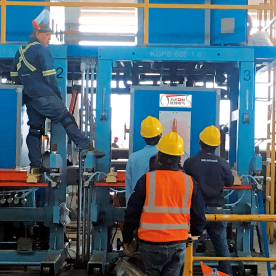[Cost-effective ERW tube mill options]Exploring Cost-effective ERW Tube Mill Options for Efficient Manufacturing in Today’s Competitive Market
News 2024-9-5
In the ever-evolving manufacturing landscape, the demand for efficient, cost-effective solutions has never been higher. One pivotal piece of equipment that has garnered attention is the Electric Resistance Welding (ERW) tube mill. With the ability to produce high-quality tubes and pipes across various industries, it’s essential to understand the cost-effective ERW tube mill options available on the market today. This article will explore different options, their benefits, and considerations for businesses looking to invest in this technology.
Understanding ERW Tube Mills
ERW tube mills are specialized machines used to manufacture welded tubes and pipes from coiled steel. The process involves feeding a flat strip of metal through a series of rollers that gradually form it into a tube. Electric resistance welding occurs as the edges of the strip are heated and fused together under pressure. This method is not only efficient but also versatile, allowing for the production of tubes in various diameters, wall thicknesses, and lengths.
The Importance of Cost-effective Solutions

Exploring Cost-effective ERW Tube Mill Options for Efficient Manufacturing in Today’s Competitive Market
Factors to Consider When Choosing a Cost-effective ERW Tube Mill
1. **Production Capacity**: Evaluate the mill's capacity to produce tubes that meet your production requirements. A mill that can handle high volume and speed efficiently will ultimately lead to lower production costs over time.
2. **Energy Efficiency**: Consider the energy consumption of the machine. Modern ERW tube mills are designed with energy-efficient technologies that can lower operational costs. Look for mills that offer features such as variable frequency drives (VFDs), which can adjust energy use based on load.

Exploring Cost-effective ERW Tube Mill Options for Efficient Manufacturing in Today’s Competitive Market
4. **Maintenance Requirements**: Assess the maintenance demands of the tube mill. Cost-effective options should not incur high maintenance costs due to frequent repairs or service needs. Choose equipment with robust engineering and fewer moving parts to minimize downtime.
5. **Technology Integration**: Investigate whether the mill has options for automation and digital integration. Technology-driven production processes can enhance efficiency and reduce labor costs, providing long-term savings.

Exploring Cost-effective ERW Tube Mill Options for Efficient Manufacturing in Today’s Competitive Market
1. **Entry-Level ERW Tube Mills**: Ideal for smaller manufacturers or those new to tube production, these mills offer essential features at a lower price point. While they may have limited capacity and speed, they provide a solid foundation for businesses looking to enter the market without a significant initial investment.
2. **Modular ERW Tube Mills**: These mills allow for flexibility in production as they can be expanded or upgraded according to evolving business needs. This adaptability can be a cost-effective solution in the long run, as businesses can invest incrementally rather than overspend on high-capacity mills that may exceed current needs.
3. **Used or Refurbished Mills**: Purchasing refurbished ERW tube mills can be a highly economical option for companies looking to minimize capital expenditure. Many manufacturers provide certification and warranty, ensuring that the machinery performs reliably.
4. **Chinese Manufacturers**: In recent years, equipment from Chinese manufacturers has gained traction due to lower prices without significant sacrifices in quality. Brands like HSG, Yoder, and others offer competitive models that can meet a variety of production requirements.
Conclusion
Investing in a cost-effective ERW tube mill is a strategic decision that can significantly impact a manufacturer’s bottom line. By carefully evaluating production requirements, energy efficiency, material compatibility, maintenance needs, and potential technology integration, businesses can choose the right mill to enhance their manufacturing capabilities. The availability of modular systems, refurbished options, and competitive offerings from international manufacturers ensures that there is a suitable choice for every business, regardless of size or market demands. With the right investment, companies can position themselves to thrive in a competitive landscape, meeting both production goals and budgetary constraints effectively.
